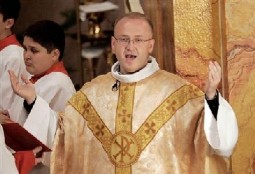Revised Roman Missal: Understanding the reasons
for the changes - Part 1
How and why the Church is improving the English translation of The Roman Missal
Et cum spiritu tuo
by Emily Stimpson
This article is reprinted from OSV Newsweekly, a publication of Our Sunday Visitor, Inc, with the kind permission of the editor, John Norton, and author / contributing editor, Emily Stimpson.
Theological quibbling.
At first glance, that's how some of the forthcoming changes to the English-language translation of The Roman Missal might appear.
The difference between words and phrases such as "consubstantial" and "one in being," or "And also with you" and "And with your spirit," seem to contain within them echoes of the classic Gershwin tune "Let's Call the Whole Thing Off."
It's all to-may-toes and to-mah-toes, po-tay-toes and po-tah-toes.
But, in fact, that's not how it is at all.
So, what are some of the changes Catholics will encounter starting on November 27, the first Sunday of Advent, that seem small but are actually quite significant?
Et cum spiritu tuo
Now we say, "And also with you."
Beginning November 27, we'll say, "And with your spirit."
Here's why:
 Besides "Amen," there's no word or phrase that Catholics repeat more often during the Mass than "And also with you."
Accordingly, one of the first things Catholics will notice is that, in the new translation, that familiar response has been changed to "And with your spirit."
Besides "Amen," there's no word or phrase that Catholics repeat more often during the Mass than "And also with you."
Accordingly, one of the first things Catholics will notice is that, in the new translation, that familiar response has been changed to "And with your spirit."
The phrase is an awkward and odd one, at least to most post-modern ears.
After all, who greets someone's spirit?
So, why the change?
To start with, it's accurate.
In the original Latin, whenever the priest says to the people Dominus vobiscum ("The Lord be with you"), the people's response is Et cum spiritu tuo, literally "And with your spirit."
It's also the way the phrase is translated in almost every other language, including French, Spanish and Italian (Et avec votre esprit, Y con tu espiritu, E con il tuo spirito), as well as by English-speaking Lutherans and Episcopalians.
"English-speaking Catholics are among the few that didn't translate the phrase accurately," said Father Rick Hilgartner, director of the U.S. Conference of Catholic Bishops' Secretariat for Divine Worship.
"The new translation draws us into parallel with other language groups and traditions."
But the correction isn't just about accuracy or parallels.
Again, the words of the Mass are there for a reason.
And the response "And with your spirit" conveys something different than "And also with you."
"The latter sounds like a cultural greeting," says Joe Paprocki, national catechetical consultant for Loyola Press, "which was the point.
The original translators wanted something that sounded more like everyday speech.
But it can sound like the congregation is saying, 'Right back at you, Father,' or 'You too.'"
And that's not what the Latin phrase means.
It's not just another way of saying "Hi" to the priest.
Rather, said Father Hilgartner, Et cum spiritu tuo is "a liturgical greeting given to the priest at four significant moments, when the priest is about to do something that by virtue of Holy Orders he has been ordained to do: preside over the Mass, proclaim the Gospel, pray the Eucharistic prayers and dismiss the congregation."
"As such," he continued, "the congregation's response is intended to remind the priest who he is, that he has been ontologically changed by ordination, and that it's the spirit of Christ, to which his own spirit has been configured, which allows him to carry out those sacred tasks."
"It's meant to be a reminder that what the priest is doing is not about him," he said.
"It's a reminder that this isn't about Father and Father's Mass.
It's about Father allowing Christ to act in him."
Likewise, "And with your spirit" isn't intended to suggest that the priest is any holier than his congregation.
Rather, said Father Neil J. Roy, who teaches liturgy at the University of Notre Dame, it "expresses a prayer that the ordained may be made worthy of the dignity of their divine calling."
The response also reminds the laity of a thing or two.
To start with, said Father Peter Stravinskas, author of The Bible and the Mass, it reminds the congregation who the priest is.
"He's not just a representative of the community.
He's not a liturgical animator.
He's there in the person of Christ," said Father Stravinskas.
It also reminds the laity, he continued, that the priest "is doing for them what they cannot do for themselves.
Through the grace of the Holy Spirit he has been conformed to Christ and is therefore able to transform gifts of bread and wine into Christ's Body and Blood."
These explanations are nothing new.
Much the same was said by Saint John Chrysostom, a fourth-century Doctor of the Church, and by his contemporary, the poet-theologian Narsai of Nisibis, in their catecheses on the Sacred Liturgy.
In one homily, Narsai preached that in responding, "And with your spirit," the congregation "call 'spirit' not the soul which is in the priest, but the Spirit which the priest has received by the laying on of the hands.
By the laying on of hands the priest receives the power of the Spirit that thereby he may be able to carry out the divine mysteries.
That grace the people call the 'Spirit' of the priest, and they pray that he may attain peace with it and it with him.
This shows that even the priest needs prayer, and it is necessary that the whole Church should intercede for him."
Good explanation then. Good explanation now.
Copyright © 2011 by Our Sunday Visitor, Inc.
Reprinted by permission of the copyright owner and the author.
| 

